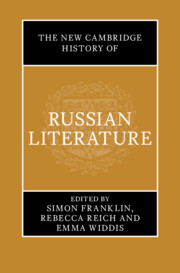Book contents
- The New Cambridge History of Russian Literature
- The New Cambridge History of Russian Literature
- Copyright page
- Contents
- Figures
- Contributors
- Acknowledgements
- On Transliteration, Names, and Dates
- Introduction
- History 1 Movements
- History 2 Mechanisms
- History 3 Forms
- History 4 Heroes
- 4.1 The Saint
- 4.2 The Ruler
- 4.3 The Lowly Civil Servant
- 4.4 The Peasant
- 4.5 The Intelligent
- 4.6 The Russian Woman
- 4.7 The New Person
- 4.8 The Non-Russian
- 4.9 The Madman
- 4.10 The Émigré
- Index
- References
4.4 - The Peasant
from History 4 - Heroes
Published online by Cambridge University Press: 31 December 2024
- The New Cambridge History of Russian Literature
- The New Cambridge History of Russian Literature
- Copyright page
- Contents
- Figures
- Contributors
- Acknowledgements
- On Transliteration, Names, and Dates
- Introduction
- History 1 Movements
- History 2 Mechanisms
- History 3 Forms
- History 4 Heroes
- 4.1 The Saint
- 4.2 The Ruler
- 4.3 The Lowly Civil Servant
- 4.4 The Peasant
- 4.5 The Intelligent
- 4.6 The Russian Woman
- 4.7 The New Person
- 4.8 The Non-Russian
- 4.9 The Madman
- 4.10 The Émigré
- Index
- References
Summary
The peasant as a protagonist in Russian literature emerged in the late eighteenth century in comic operas and Nikolai Karamzin’s short fiction. By the 1850s, the genre of ‘stories from the life of peasants’ had become widespread, and included the depiction of Ukrainian peasants. Its popularity hinged on the fact that peasant ‘other’ came to serve as an idealised image of national character. This chapter focuses in most detail on the period between the emancipation of the serfs in 1861 and the Russian Revolution in 1917, when the models used for depicting peasants were most diverse, and the ‘grey muzhik’, or average peasant, featured in the work of many writers. Under Stalin, the free-labour peasant disappeared from Russian literature due to collectivisation and repressions, only to re-emerge in the Village Prose of the late Soviet period as writers transformed citizens of collective farms into nostalgic images of a lost Russia.
Keywords
- Type
- Chapter
- Information
- The New Cambridge History of Russian Literature , pp. 737 - 755Publisher: Cambridge University PressPrint publication year: 2024

